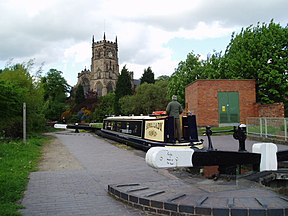Staffordshire and Worcestershire Canal
| Staffordshire and Worcestershire Canal | |
|---|---|

Kidderminster Lock on the Staffordshire and Worcestershire Canal
|
|
| History | |
| Principal engineer | James Brindley |
| Date of act | 14 May 1766 |
| Date of first use | 1772 |
| Date completed | 1771 |
The Staffordshire and Worcestershire Canal is a navigable narrow canal in Staffordshire and Worcestershire in the English Midlands. It is 46 miles (74 km) long, linking the River Severn at Stourport in Worcestershire with the Trent and Mersey Canal at Haywood Junction by Great Haywood.
James Brindley was the chief engineer of the canal, which was part of his "Grand Cross" plan for waterways connecting Hull, Liverpool and Bristol.
The Act of Parliament authorising the canal was passed on 14 May 1766. This created "The Company of Proprietors of the Staffordshire and Worcestershire Canal Navigation", which was empowered to raise an initial £70,000 (equivalent to £8,778,850 in 2015),, with a further £30,000 (equivalent to £3,762,364 in 2015), if needed, to fund the canal's construction.
The canal was completed in 1771 for a cost that exceeded the authorised capital, and opened to trade in 1772. It was a commercial success, with trade from the Staffordshire Potteries southwards to Gloucester and Bristol, and trade from the Black Country northwards to the Potteries via the junction with the Birmingham Canal at Aldersley.
The Company obtained a second Act of Parliament on 9 June 1790, authorising it to raise another £12,000 (equivalent to £1,293,159 in 2015), to improve the River Severn immediately below Stourport as far as Diglis, to improve navigation to and from the canal. At Stourport there were four basins, linked by broad locks, that allowed broad-beamed Severn trows to enter them from the river. Goods could then be trans-shipped from the canal narrow boats to the trows for onward shipment to Bristol.
...
Wikipedia
